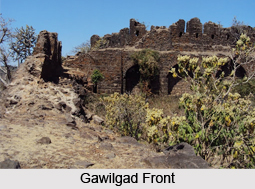 Gawilgarh Fort is an ancient hill fort which is located in the vicinity of Melghat Tiger Reserve in the district of Amravati in Maharashtra state. The geographical coordinates of the site are latitude 21°22`56?N 77°20`2?E and longitude 21.382222°N 77.333889°E. The structure was built by Ahmed Shah I of Gujarat in 1425 CE. It is constructed with stone and is situated at a height of 1,103 m. Gawilgarh Fort is also known as Gawilgad and Gawilghur. The fortress was one of the major strongly fortified defensive structures of the Maratha Empire north of the Deccan Plateau. Eventually the fortress was occupied by the British East India Company on the 15 December 1803 under the leadership by Arthur Wellesley during the Second Anglo Maratha War.
Gawilgarh Fort is an ancient hill fort which is located in the vicinity of Melghat Tiger Reserve in the district of Amravati in Maharashtra state. The geographical coordinates of the site are latitude 21°22`56?N 77°20`2?E and longitude 21.382222°N 77.333889°E. The structure was built by Ahmed Shah I of Gujarat in 1425 CE. It is constructed with stone and is situated at a height of 1,103 m. Gawilgarh Fort is also known as Gawilgad and Gawilghur. The fortress was one of the major strongly fortified defensive structures of the Maratha Empire north of the Deccan Plateau. Eventually the fortress was occupied by the British East India Company on the 15 December 1803 under the leadership by Arthur Wellesley during the Second Anglo Maratha War.
History of Gawilgarh Fort
Gawilgarh Fort was built by the ninth king of the Berar dynasty, Ahmed Shah Wali, in 1425 when he was camped at Ellichpur. During the 2nd Maratha War, the fortification was besieged in 1803 by the army of the British East India Company under the command of Arthur Wellesley. The British forces initially failed to capture the fortress. Later Captain Campbell, along with the 94th Scottish Brigade, charged through the northern gateway. The British army suffered heavy casualties. Afterwards, Gawilgarh Fort was given back to the Maratha Empire after establishment of peace with the British administration.
Architecture of Gawilgarh Fort
Gawilgarh Fort consisted of almost seven entrances. There were 2 separate water reservoirs, namely Khantalav and Devtalav, in the premise of the fort. These cisterns were the main source of water for the inhabitanst of the fortress. It also comprises of an ancient mosque which is located in the vicinity. It is built at the highest point of the inner fort. The mosque was constructed in the Pathan style of architecture. The mosque included a seven arched facade and a square canopy with elaborate stone latticework. It also had 2 towers with balconies but only one of the minrates is intact at present.
Present Condition of Gawilgarh Fort
Currently the fort at Gawilgarh lies in a ruined and dilapidated state. The structure is owned and maintained by the Government of India. At present the site is open to all tourists and visitors throughout the year.



















